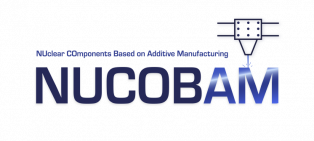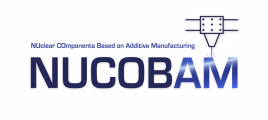Additive manufacturing (AM) (also known as 3D printing) presents an opportunity for nuclear power plants to replace machinery and parts with relative ease and speed compared to traditional methods using processes such as welding, machining and casting. In order to be able to use AM in nuclear facilities, nuclear stakeholders must have confidence in the manufactured components. This means that before installing these components, they must go through rigorous testing and quality control.
NUCOBAM aims at developing the qualification process and evaluating in-service behaviour of nuclear components made by AM. NUCOBAM will conduct the required studies to implement the AM process in nuclear design codes and standards to produce components for nuclear power generation equipment.
- The first part will consist of a collection of the physical, mechanical, and microstructural characterisation of the materials from 4 manufacturers that result from the AM process (using 4 heat treatments) in order to establish a qualification and codification process.
- The second part will be dedicated to the evaluation of AM material behaviour in-service, especially regarding main degradation mechanisms that occur in Light Water Reactors (LWR) (thermal ageing, irradiation…). Materials will be manufactured and some of them will be submitted to post-treatment (heat treatment or high isostatic pressure).
This work will allow manufacturers and designers to evaluate and deduce the main parameters required for specification. By gathering the main European industrial and research/academic players in the nuclear sector to participate in the project, NUCOBAM will directly contribute to the development of future nuclear safety policy. The project was awarded the SNETP label(formerly the NUGENIA label) for addressing issues in several Technical Areas (find the project factsheet on SNETP here).
NUCOBAM achievements will provide high value for nuclear power plants with new possibilities for components design with improved performances and safety.
NUCOBAM results will allow for the optimisation of designing future (large reactors or small modular reactors), ex-vessel pressure retaining components and possibly non pressure retaining classified components.
Project Objectives
To establish a qualification methodology for AM nuclear components
to be proposed for standardisation and to be communicated to nuclear design code committees
Develop a laser powder bed fusion manufacturing plan
that ensures and demonstrates process stability, repeatability and reproducibility that meet nuclear quality standards.
Demonstrate that laser powder bed fused material performance meets qualification requirements.
Evaluate the effect of irradiation on the behaviour of the laser powder bed fused in-core use case
to see whether it meets its safety-related function and operational requirements
Assess the operational performance of ex-core AM components
regarding safety-related function and operational requirements.
Disseminate and prepare the exploitation of results
with nuclear industries and regulatory bodies in support to codification and industrialisation of AM

